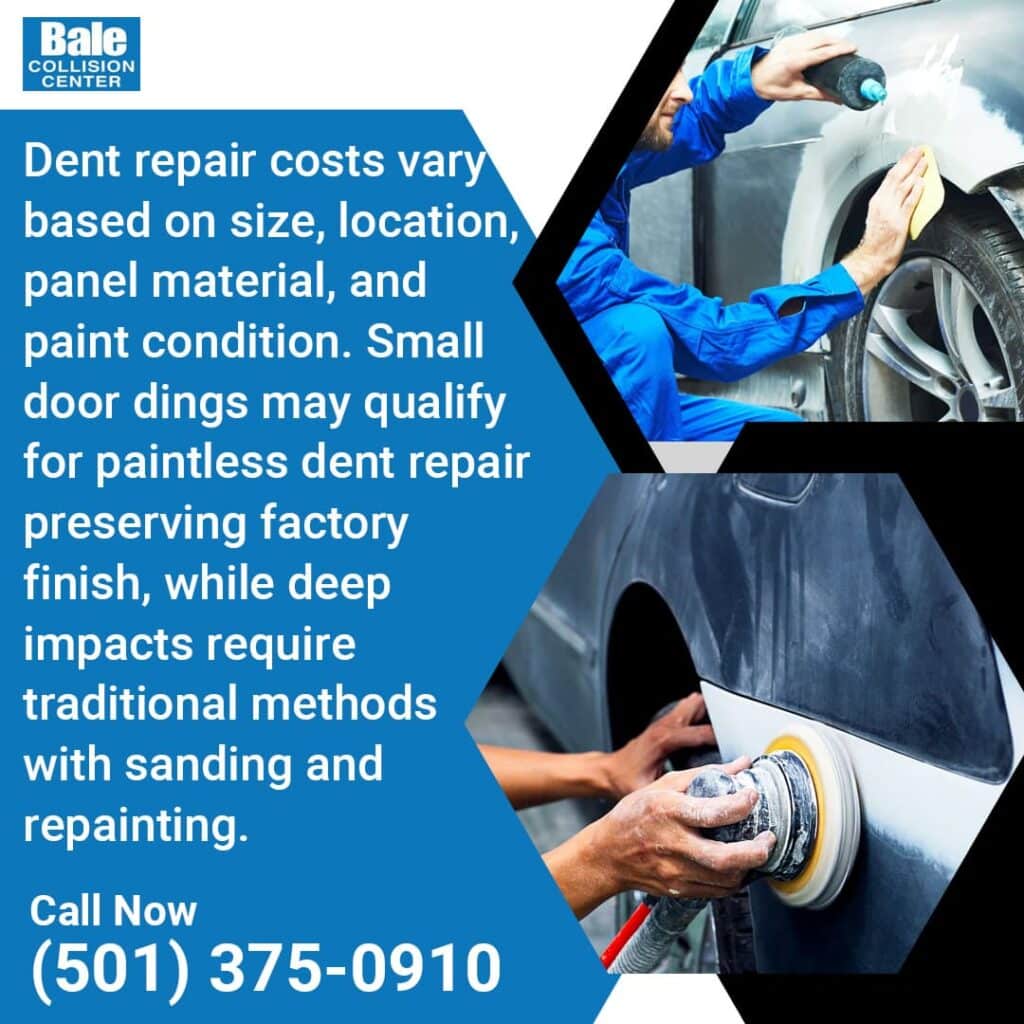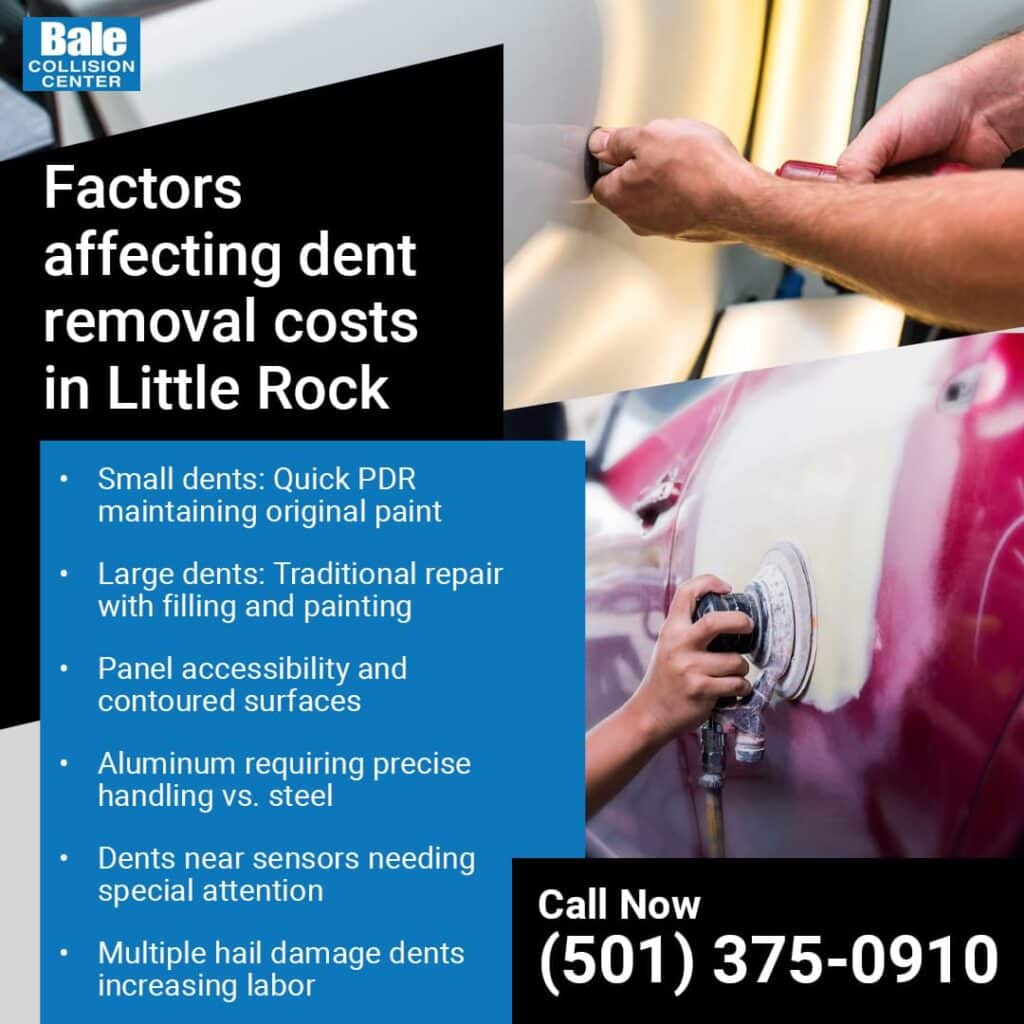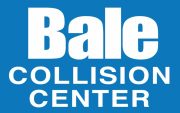Car owners in Little Rock often face the challenge of understanding why the cost of dent repairs can vary so widely. Minor dings from parking lots or extensive hail damage across multiple panels may appear similar at a glance, but the repair approach and pricing differ substantially. The two primary repair methods, paintless dent repair (PDR) and traditional body repair, carry different costs, timelines, and long-term effects on a vehicle’s value. PDR is generally less expensive because it restores dents without repainting, but traditional repair is required when paint damage, stretched metal, or structural issues are present. Knowing which method applies to your situation helps prevent unexpected expenses and ensures your vehicle receives the correct level of care.
At Bale Collision Center (Downtown) in Little Rock, AR, we see how these factors directly impact our customers’ decisions and budgets. Stakeholders often need clarity on why one dent might be resolved affordably within hours using certified PDR, while another requires a more involved process with higher labor and material costs. Location of the dent, accessibility, vehicle material, and the presence of multiple impacts, such as those caused by Arkansas hailstorms, are just a few of the considerations that influence the final estimate. By addressing these variables upfront, our team helps customers make informed repair choices that balance cost, quality, and long-term vehicle value.

Size, Depth, and Shape of the Dent
Minor Dings and Door Dents
Small dents usually cost less to repair because they require less time and fewer steps. These dents are most commonly caused by door bumps in parking lots, shopping carts, or small debris on the road. When the paint is not damaged, paintless dent repair (PDR) is the preferred method. It restores the panel without sanding or repainting, which helps maintain the factory finish and resale value. For customers, this usually means quicker service and a lower cost compared to traditional repairs. Certified PDR keeps long-term maintenance expenses lower.
Large or Complex Dents
Larger dents require more work and are usually more expensive to repair. Impacts from collisions, falling tree limbs, or Arkansas hailstorms can leave dents that are both deep and wide. When dents include creases or stretched metal, PDR may not be possible. In these cases, traditional dent removal services are necessary. That process involves reshaping the surface, applying filler, sanding, and repainting the affected area. The extra steps increase material and labor costs, but they are necessary to restore the car’s appearance and safety. Customers should expect higher estimates for this type of repair.
Impact on Labor and Tools Required
The cost of dent repair increases when more tools and labor are needed. Paintless dent repair relies on specialized tools such as rods, glue pullers, and lights to reshape the metal. Some dents are accessible directly, while others require removing panels or interior trim to reach the backside of the dent. This adds extra labor hours.
Traditional repairs require multiple steps, including sanding, applying body filler, priming, and fully repainting the affected panel. These steps add both time and material costs. Understanding these differences helps explain why small dents repaired with PDR are usually more affordable, while complex dents can require larger budgets.
At Bale Collision Center, we evaluate each dent carefully to decide whether certified PDR or traditional car dent removal will deliver the best result. Our goal is to provide customers with car dent removal options that balance cost, time, and quality.
Number and Distribution of Dents
The number and spread of dents affect repair effort, as widespread or multiple-panel damage requires more time and resources to restore properly. Repair difficulty increases when dents are spread across multiple panels. A single dent can often be addressed quickly, but widespread hail damage requires more time and effort. Each dent must be accessed individually, which makes the repair process more complex.
Paintless dent repair is often the preferred option for hail damage repair because it can restore multiple dents while maintaining the vehicle’s factory finish. When storms affect many cars at once, repair schedules can extend even further. In cities like Little Rock, this often happens during peak hail season, making timely booking an important step in the process.
At Bale Collision Center, we explain how dent quantity and distribution influence repair planning. Our certified technicians provide car dent removal in Downtown Little Rock, Arkansas, with clear timelines tailored to each situation, helping customers manage both time and repair expenses efficiently.
Accessibility and Panel Type
Flat Panels vs Contoured Surfaces
Flat panels are easier to repair with PDR compared to contoured surfaces. A flat door or hood provides more direct access for tools, making dent removal faster and more consistent. By contrast, curved or sculpted body lines require greater precision because the metal must be restored without distorting the design. In many cases, contoured areas also limit tool movement, which extends repair time.
Areas Near Sensors or Reinforcement Structures
Dents near sensors or reinforcement areas add complexity to the repair. Modern vehicles often include reinforcement beams behind doors and bumpers, along with advanced driver assistance sensors in critical panels. When damage occurs in these locations, technicians must take extra care to preserve functionality. In some cases, panel removal or temporary disconnection of systems may be necessary, which changes how dent removal services are performed.
Repairing dents on contoured panels or near sensors and reinforcement structures increases labor and resources required, which typically raises the overall cost of dent removal and paintless dent repair.
Vehicle Materials and Design Considerations
Aluminum, Steel, or Specialty Finishes
The materialof the panel affects how PDR is performed. Steel panels are commonly used and generally respond well to paintless dent repair. Aluminum, however, is less flexible and requires more precise toolwork, which can extend the time needed for dent removal services. Specialty finishes, such as matte or high-gloss coatings, must also be handled carefully to avoid altering the vehicle’s appearance. The repair approach must always match the panel material and finish to protect the factory look.
Older vs Newer Models and Their Repair Challenges
The age and design of a vehicle influence repair methods. Older models often feature thicker steel that resists reshaping, making PDR more challenging. Newer models, especially those with lightweight materials and advanced safety structures, present different complexities. For example, reinforced crumple zones or integrated sensor systems may restrict access to dents. These design features require certified PDR technicians who understand how to work around modern vehicle systems without disrupting their function.
Panel material and vehicle design influence the time and skill required for repairs, so aluminum, specialty finishes, or vehicles with advanced safety features generally result in higher dent repair costs. At Bale Collision Center, we evaluate both the material and design of each vehicle before choosing an approach.
Paint and Surface Integrity
Maintaining the original paint is a key advantage of paintless dent repair. Damaged paint can reduce resale value, so keeping it intact is important. Certified PDR technicians use specialized tools and techniques to carefully massage dents from behind the panel while avoiding scratches, chips, or finish distortion.
When Paint Repair Is Necessary
Paint repair becomes necessary when the surface is chipped, cracked, or otherwise compromised. Dents that break the clear coat or expose metal require refinishing to protect against corrosion and restore a uniform look. In these cases, traditional dent repair methods, which include sanding, priming, and repainting, provide proper adhesion and a consistent finish. This process increases material use, labor time, and drying requirements, which adds to the overall expense compared to paintless dent repair, where the original finish is preserved.
Evaluating paint integrity before selecting a repair method helps determine the most effective and reliable approach for each vehicle.

Long-Term Savings from Professional Dent Repair
Professional dent repair helps avoid future expenses by preventing damage from worsening over time. Correctly addressing dents stops rust, corrosion, and structural issues that could require costly interventions later. When left untreated, even small dents collect moisture or debris, which accelerates damage and leads to more extensive repairs.
Reducing repeated repairs saves money. Improper or rushed repairs often lead to recurring damage, increasing labor and material costs over time. A thorough initial repair corrects the dent completely, reducing the need for additional service calls and lowering overall repair frequency.
Preserving vehicle value protects your investment. Maintaining the original finish and properly restored panels keeps resale and trade-in values higher, lowering long-term financial loss. Vehicles with poorly repaired or untreated dents can lose value quickly, as visible damage or rust signals potential hidden issues to buyers.
At Bale Collision Center, our certified car dent removal in Downtown Little Rock, Arkansas, focuses on long-term protection for your vehicle. By addressing dents thoroughly and correctly the first time, we help customers minimize future repair costs while maintaining appearance and functionality.
Final Considerations and Repair Guidance
The cost and approach to dent repair depend on multiple factors. Dent size, depth, and shape, the number of affected panels, accessibility, panel material, and paint condition all influence the repair method. Certified PDR is ideal for minor dents and preserves the original paint, while deeper dents, stretched metal, or structural concerns require traditional repair methods. Understanding these factors ensures effective restoration and long-term vehicle protection.
Taking the Next Step
Professional evaluation is the most reliable way to determine the right repair solution. At Bale Collision Center, we provide detailed assessments for car dent removal in Downtown Little Rock, Arkansas. Our experienced team guides vehicle owners through the process, restoring both appearance and function efficiently.
Restore your vehicle’s appearance and safety with certified dent removal services at Bale Collision Center. Call us at (501) 375-0910 or email bccdowntown@baleautomotive.com to book your assessment for paintless dent repair, hail damage repair, and other dent removal services.
